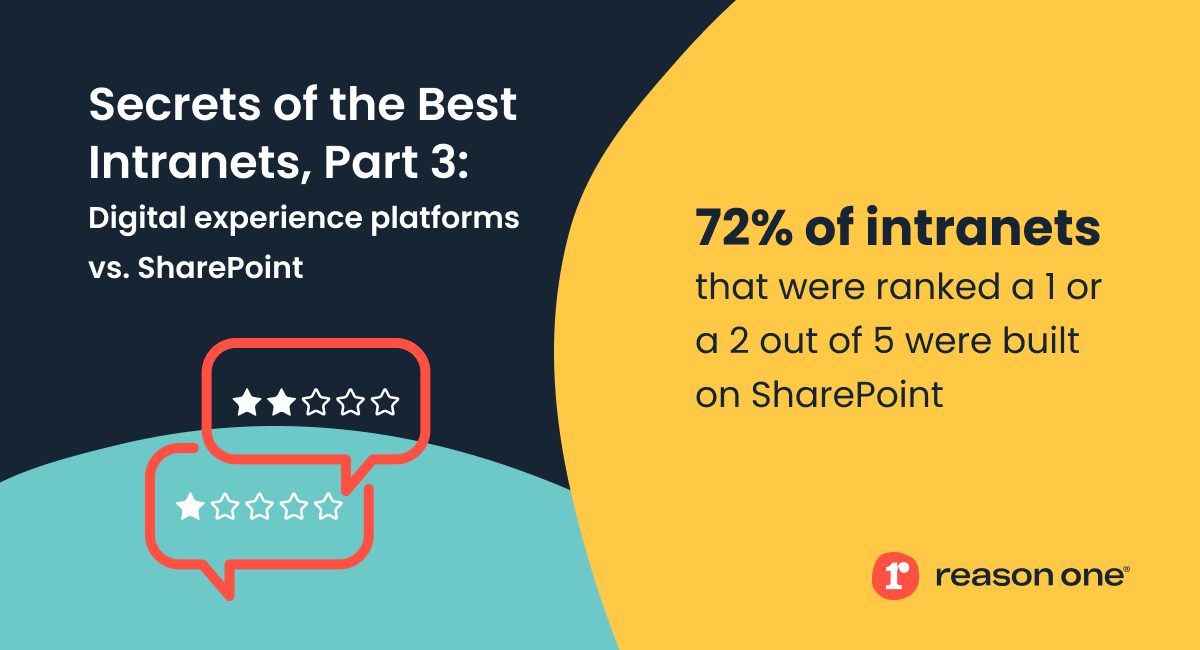Choose the Best Intranet Platform for UX
Summary: In a recent survey, we found that SharePoint is the most widely used platform—coming in at 27%. But why? SharePoint is a tech decision, not one that puts users first. Find out why we recommend using an experience-based platform instead. Does accessing your intranet feel like an epic journey through a vast maze of file structures? There has to be a better way.
Why Not to Use Sharepoint for Your Intranet
SharePoint was built for managing documents—not delivering engaging user experiences. This key limitation often leads to intranet failures.
Only 9% of top-performing intranets use SharePoint. Many organizations choose it simply because they already have it, but that’s not a strong enough reason to rely on it for your intranet.
Using a DXP for Your Intranet
The next five most-used platforms in the survey were experience-based, the same platforms used to create much-loved public websites. Often referred to as content management systems or digital experience platforms (DXPs), these tools are built to manage and deliver content through a dynamic user experience across all devices. Most importantly, DXPs can be designed to work the way you do rather than forcing you to conform to the platform.
Given what we’ve said about engagement strategy, it’s no surprise that intranets built on experience-based platforms are nearly 3x more effective than those built on SharePoint.
In fact, 72% of intranets ranked a 1 or 2 out of 5 in effectiveness were built on SharePoint.
 Additionally, 44% of healthcare organizations using experience-based platforms also had a written strategy, compared to only 23% of those using SharePoint.
Additionally, 44% of healthcare organizations using experience-based platforms also had a written strategy, compared to only 23% of those using SharePoint.
DXPs Create Efficiency
Experience-based platforms offer efficiency in ways that SharePoint cannot. For example, you can build your intranet and public websites on the same platform. This saves on license fees while making it easier to share content and data between your digital properties. Additionally, using a single platform reduces the need for extensive training, enabling web content managers to more easily support both internal and external sites—an essential benefit for resource-strapped teams.
DXPs Integrate with SharePoint
For many organizations, SharePoint remains a vital tool for document management and isn’t going away anytime soon. But this doesn’t have to be an either/or decision. Many high-quality experience-based platforms include SharePoint connectors, allowing you to maintain taxonomy and access within SharePoint while delivering a more effective and engaging intranet experience for users. This hybrid approach works well for organizations that need the strengths of both platforms.
Your Platform Is Part of a Larger Conversation
Making these changes won’t happen overnight, but you can start the process today by putting people first. Begin by gathering surveys, analytics, and feedback to build a case for executives. Examine who owns your intranet and consider whether changing ownership could improve UX. Additionally, identify the top tasks your users need to accomplish, along with their frustrations, and work to address them.
Ultimately, everyone deserves a seat at the table. Your intranet is how your team members connect. The more effective it is, the more people will use it to do their jobs well—and isn’t that the goal? The answer is a resounding yes.
Want to dive deeper? Watch the full webinar on the Secrets of the Best Intranets here.
Stay Informed on Intranet Insights
Want more expert advice on choosing the right intranet platform and improving employee engagement? Subscribe to our newsletter for actionable strategies, industry trends, and exclusive resources to help you create an intranet that works for your team.
